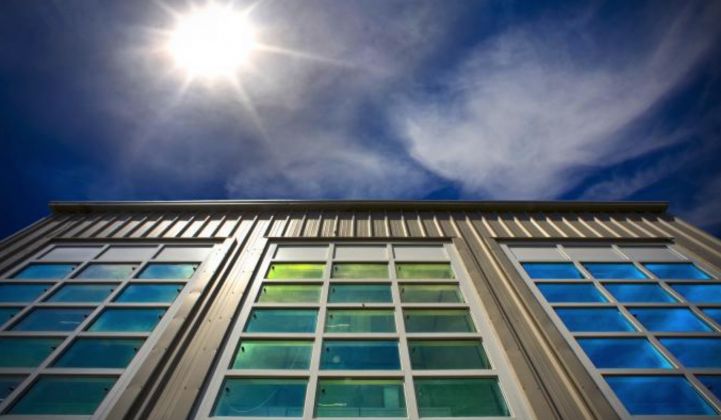Researchers at Lawrence Berkeley National Laboratory are working with manufacturers to commercialize a triple-glazed “super window” that’s at least twice as insulating as the most common window sold in the United States today. If commercialized, the window could save $10 billion annually in U.S. energy costs.
Some 90% of the windows sold in the United States are double-glazed models with low-emissivity (low-E) coatings. Two layers of glass covered with low-E coatings enclose a gap with filled argon gas.
The low-E coatings reflect long-wave infrared radiation, felt as heat, while allowing visible light to enter the building, and can be customized to improve both heating and cooling performance based on the climate zone.
The “thin triple super window” builds upon this model by inserting an ultra-thin layer of glass between the two existing panes, adding a second low-E coating, and trading argon gas for better-insulating krypton gas in the gaps between the panes.
Because the super window is the same width and nearly the same weight as existing market-leading double-glazed windows, manufacturers will not need to redesign the window sash and frame. The new window therefore presents a tantalizing opportunity: a more efficient drop-in replacement for existing double-glazed windows.
An innovation whose time has come
Thus far, LBNL researchers have built and tested prototypes of the super window in the lab. The research team includes veterans of a previous effort to bring a window innovation to market.
“We worked on a similar successful transformation once before,” Stephen Selkowitz told Greentech Media in an email, citing the lab’s work to commercialize low-E windows in the 1980s. Selkowitz is an LBNL researcher and co-inventor of the super window.
He cautioned that it can take many years for promising technologies to gain traction in the window industry. Decades passed before low-E windows became the default technology.
The payoff for a market-shifting technology can be substantial. Selkowitz said low-E windows have saved a cumulative $150 billion in avoided energy costs in the United States.
LBNL invented and patented the super window more than 20 years ago. But it was a concept ahead of its time. Manufacturers could not then source the large sheets of the ultra-thin glass required for a commercial product.
“Twenty years ago, we couldn’t find any companies that could make thin glass sheets in volume,” LBNL researcher Charlie Curcija said in a statement. “Now the flat-screen TV industry has pushed the glass industry to create precisely the glass we need for windows, and at a price the window market can afford.”
“The window industry isn’t turning over new products at the same rate as smartphones or TVs,” added Selkowitz. “In this case, those industries have helped make our approach viable with the massive ramp-up of thin glass production.”
Huge energy savings potential
According to LBNL, about $20 billion worth of energy leaks out of windows in the United States each winter. The super window could cut those energy losses in half. Double-paned, low-E windows have an R-value of R4.
R-value is a measure of a material’s thermal resistance. The higher the R-value, the better an insulating material can prevent heat transfer. The thin triple super window has an R-value of R8 to R10.
Selkowitz estimates that if a homeowner in a cold climate replaced their existing double-paned windows with LBNL’s super windows, the household could save $250 to $750 annually. If a homebuilder installed super windows instead of double-paned windows with low-E coatings in a new home, the homeowner could save $100 to $300 annually.
“In retrofit, the paybacks look pretty good compared to the base case,” concluded Selkowitz. “In new construction, the paybacks are longer because the base case is already an efficient product.”
The path to market
LBNL is working with two manufacturers, Andersen Corporation, America’s largest window and door maker, and Alpen High Performance Products, to commercialize the super window.
Selkowitz said “solvable” obstacles must be overcome before a window manufacturer can launch a product line. The obstacles include bringing down costs, building out the supply chain for the ultra-thin glass and kypton gas, developing new techniques for automated assembly of the IGU [insulating glass unit], and durability.
“Our goal is to try to resolve the major remaining technical issues in about a year’s time,” he said. “If the outcome is positive, it would then take a company some time to ramp up sourcing, production and marketing.”
Another piece of LBNL’s commercialization plan is to create demand for the new window by raising awareness of the technology among utilities, building code officials and architects.
“Decades of similar work in energy efficiency tells us that if the market demand is not there, then the technology won’t be adopted,” said Selkowitz.




